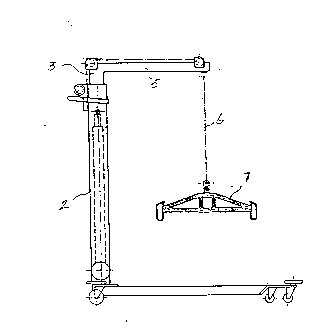Some of the information on this Web page has been provided by external sources. The Government of Canada is not responsible for the accuracy, reliability or currency of the information supplied by external sources. Users wishing to rely upon this information should consult directly with the source of the information. Content provided by external sources is not subject to official languages, privacy and accessibility requirements.
Any discrepancies in the text and image of the Claims and Abstract are due to differing posting times. Text of the Claims and Abstract are posted:
| (12) Patent: | (11) CA 1310291 |
|---|---|
| (21) Application Number: | 1310291 |
| (54) English Title: | MOBILE APPARATUS FOR LIFTING PATIENTS |
| (54) French Title: | APPAREIL MOBILE POUR LEVER LES PATIENTS |
| Status: | Term Expired - Post Grant |
| (51) International Patent Classification (IPC): |
|
|---|---|
| (72) Inventors : |
|
| (73) Owners : |
|
| (71) Applicants : | |
| (74) Agent: | NORTON ROSE FULBRIGHT CANADA LLP/S.E.N.C.R.L., S.R.L. |
| (74) Associate agent: | |
| (45) Issued: | 1992-11-17 |
| (22) Filed Date: | 1987-01-26 |
| Availability of licence: | N/A |
| Dedicated to the Public: | N/A |
| (25) Language of filing: | English |
| Patent Cooperation Treaty (PCT): | No |
|---|
| (30) Application Priority Data: | ||||||
|---|---|---|---|---|---|---|
|
ABSTRACT:
Floor supported mobile lifting apparatus for diseased or
invalid persons are known and consist of a wheel base
having a vertical column and a lifting arm projecting
therefrom, in which lifting arm said person is supported
by a lifting element. In order to improve known lifting
apparatus of above-mentioned type so that it is prevented
that the centre of gravity will be moved during the
lifting movement of the patient the column is formed of
two parts (2, 3) of which one (3) is driven by a motor
to move up and down in parallel relation to the second
part (2) or telescoping over the second part (2), whereby
the second part is secured to a wheel base and the movable
part in its free end supports the lifting arm (5).
A hoisting cable (6) is fixed at the second part and is
running in stearing means (8) over the top end of the
first part and along the lifting arm (5) and suspends
from here. The free end of the cable (6) supports the
lifting element (10) , the operation being so that when
the first part (3) of the column is projected upwards
in relation to the second part (2), the free end of the
hoisting cable will be placed in the neighbourhood of
the free end of the lifting arm (5).
Note: Claims are shown in the official language in which they were submitted.
Note: Descriptions are shown in the official language in which they were submitted.

2024-08-01:As part of the Next Generation Patents (NGP) transition, the Canadian Patents Database (CPD) now contains a more detailed Event History, which replicates the Event Log of our new back-office solution.
Please note that "Inactive:" events refers to events no longer in use in our new back-office solution.
For a clearer understanding of the status of the application/patent presented on this page, the site Disclaimer , as well as the definitions for Patent , Event History , Maintenance Fee and Payment History should be consulted.
| Description | Date |
|---|---|
| Inactive: Expired (old Act Patent) latest possible expiry date | 2009-11-17 |
| Inactive: Office letter | 2006-12-06 |
| Inactive: Corrective payment - s.78.6 Act | 2006-11-28 |
| Grant by Issuance | 1992-11-17 |
There is no abandonment history.
| Fee Type | Anniversary Year | Due Date | Paid Date |
|---|---|---|---|
| MF (category 1, 5th anniv.) - standard | 1997-11-17 | 1997-11-14 | |
| MF (category 1, 6th anniv.) - standard | 1998-11-17 | 1998-11-12 | |
| MF (category 1, 7th anniv.) - standard | 1999-11-17 | 1999-11-05 | |
| MF (category 1, 8th anniv.) - standard | 2000-11-17 | 2000-11-14 | |
| MF (category 1, 9th anniv.) - standard | 2001-11-19 | 2001-10-25 | |
| MF (category 1, 10th anniv.) - standard | 2002-11-18 | 2002-11-08 | |
| MF (category 1, 11th anniv.) - standard | 2003-11-17 | 2003-10-20 | |
| MF (category 1, 12th anniv.) - standard | 2004-11-17 | 2004-10-19 | |
| MF (category 1, 13th anniv.) - standard | 2005-11-17 | 2005-11-04 | |
| MF (category 1, 14th anniv.) - standard | 2006-11-17 | 2006-10-18 | |
| 2006-11-28 | |||
| MF (category 1, 15th anniv.) - standard | 2007-11-19 | 2007-10-30 | |
| MF (category 1, 16th anniv.) - standard | 2008-11-17 | 2008-10-29 |
Note: Records showing the ownership history in alphabetical order.
| Current Owners on Record |
|---|
| GUNNAR LILJEDAHL |
| Past Owners on Record |
|---|
| None |